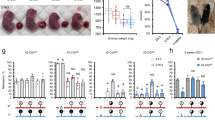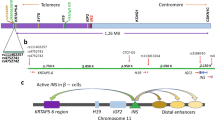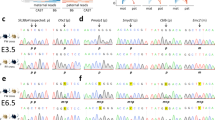Abstract
The phenomenon of parental imprinting involves the preferential expression of one parental allele of a subset of chromosomal genes and has so far only been documented in the mouse. We show here, by exploiting sequence polymorphisms in exon nine of the human insulin–like growth factor 2 (IGF2) gene, that only the paternally–inherited allele is active in embryonic and extra–embryonic cells from first trimester pregnancies. In addition, only the paternal allele is expressed in tissues from a patient who suffered from Beckwith–Wiedemann syndrome. Thus the parental imprinting of IGF2 appears to be evolutionarily conserved from mouse to man and has implications for the generation of the Beckwith–Wiedemann syndrome.
This is a preview of subscription content, access via your institution
Access options
Subscribe to this journal
Receive 12 print issues and online access
$209.00 per year
only $17.42 per issue
Buy this article
- Purchase on Springer Link
- Instant access to full article PDF
Prices may be subject to local taxes which are calculated during checkout
Similar content being viewed by others
References
Surani, M.A.H. Genomic imprinting: Developmental significance and molecular mechanisms. Curr. Op. genet. Develop. 1, 241–246 (1991).
Solter, D. Differential imprinting and expression of maternal and paternal genomes. Annu. rev. Genet. 22, 127–146 (1988).
Barlow, D., Stöger, R., Herrmann, B., Saito, K. & Schweifer, N. The mouse insulin-like growth factor type-2 receptor is imprinted and closely linked to the Tme locus. Nature 349, 84–87 (1991).
Bartolomei, M., Zemel, S. & Tilghman, S. Parental imprinting of the mouse H19 gene. Nature 351, 153–155 (1991).
DeChiara, T., Robertson, E. & Efstratiadis, A. Parental imprinting of the mouse insulin-like growth factor 2 gene. Cell 64, 849–859 (1991).
Leff, S.E. et al. Maternal imprinting of the mouse Snrpn gene and conserved linkage homology with the human Prader-Villi syndrome region. Nature Genet. 2, 265–269 (1992).
Zhang, Y. & Tycko, B. Monoallelic expression of the human H19 gene. Nature Genet. 1, 40–44 (1992).
Rachmilewitz, J. et al. Parental imprinting of the human H19 gene. FEBS Lett. 309, 25–28 (1992).
Reik, W. Genomic imprinting and genetic disorders in man. Trends Genet. 5, 331–336 (1989).
Hall, J.G. Genomic imprinting: review and relevance to human diseases. Am. J. hum. Genet. 46, 103–123 (1990).
Junien, C. Beckwith-Wiedemann syndrome, tumorigenesis and imprinting. Curr. Op. Genet. Develop. 2, 431–438 (1992).
Özcelik, T. et al. Small ribonucleoprotein polypeptide N (SNRPN), an expressed gene in the Prader-Villi syndrome critical region. Nature Genet. 2, 265–269 (1992).
Little, M., van Heyningen, V. & Hastie, N. Dads and disomy and disease. Nature 351, 609–610 (1991).
Lawler, S.D. & Fisher, R. The contribution of the paternal genome: hydatidiform mole and choriocarcinoma in The Placenta (eds Redman, C.W.G., Sargent, I.L & Starkey, P.) 82–112 (Blackwell Scientific Publications, Oxford, 1993).
Ohlsson, R., Holmgren, L., Glaser, A., Szpecht, A. & Pfeifer-Ohlsson, S. (1989). Insulin-like growth factor 2 and short-range stimulatory loops in control of human placental growth. EMBO J. 8, 1993–1999.
Ohlsson, R., Larsson, E., Nilsson, O., Wahlström, T. & Sundström, P. Blastocyst implantation precedes induction of insulin-like growth factor II gene expression in human trophoblasts. Development 106, 555–559 (1989).
Brice, A.L., Cheetham, J.E., Bolton, V.N., Hill, N.C.W. & Schofield, P.N. Temporal changes in the expression of the insulin-like growth factor II gene associated with tissue maturation in the human fetus. Development 106, 543–554 (1989).
Jansen, M. et al. in Growth Factors: From Genes to Clinical Application (eds Sara, V. et al.) 25–40 (Raven Press, New York 1990).
Julier, C. et al. Insulin-IGF2 region on chromosome 11p encodes a gene implicated in HLA-DR4-dependent diabetes suceptibility. Nature 354, 155–159 (1991).
Haig, D. & Graham, C. Genomic imprinting and the strange case of the insulin-like growth factor II receptor. Cell 64, 1045–1046 (1991).
Chomcynski, P. & Sacchi, N. A single-step method for isolation of RNA. Analyt. Biochem. 162, 156–159 (1987).
Author information
Authors and Affiliations
Rights and permissions
About this article
Cite this article
Ohlsson, R., Nyström, A., Pfeifer-Ohlsson, S. et al. IGF2 is parentally imprinted during human embryogenesis and in the Beckwith–Wiedemann syndrome. Nat Genet 4, 94–97 (1993). https://doi.org/10.1038/ng0593-94
Received:
Accepted:
Issue Date:
DOI: https://doi.org/10.1038/ng0593-94
This article is cited by
-
A comprehensive analysis of gene expression changes in a high replicate and open-source dataset of differentiating hiPSC-derived cardiomyocytes
Scientific Reports (2021)
-
What Did We Learn from the Molecular Biology of Adrenal Cortical Neoplasia? From Histopathology to Translational Genomics
Endocrine Pathology (2021)
-
Insulin-like growth factor 2 (IGF2) expression in adrenocortical disease due to PRKAR1A mutations compared to other benign adrenal tumors
Endocrine (2021)
-
Blood transcriptome analysis in a buck-ewe hybrid and its parents
Scientific Reports (2019)



